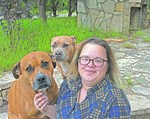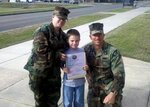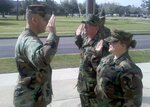


Being a woman and Seabee in the Navy comes with several challenges just to be accepted by fellow seamen and treated as an equal.
Granbury resident Jennifer Carrig, said she had to work twice as hard to earn her place as a Seabee. But in return, she was assigned a special job over time and assumed the role and responsibility as “the mom” — the toughest job in her battalion.
Carrig was born and raised in Germany before she immigrated to the U.S. at 18. She got married to her then-husband, whom she was married to for nine years, and together they had a son, Collin.
After her husband lost his job and she realized they had no way to support Collin, Carrig took matters into her own hands and walked into the Air Force recruiting office.
Because she was technically a single parent at the time, she was turned away. Feeling defeated, Carrig walked out and came across a Navy recruiter.
“He was like, ‘Air Force didn't want to listen?’ I'm like, ‘Nah.’ He said, ‘Come on in,’” she said.
Unfortunately, Carrig wasn’t yet a U.S. citizen, but the Navy recruiter allowed her to talk with a Seabee, who recruited her at the age of 23.
She attended boot camp where she was first recognized as the “mother” of her battalion.
“Each person in boot camp had these little odd jobs like laundry petty officer and I never got a job assigned to me, so when I asked my RDCs, (Recruit Division Commanders) they said, ‘You have the toughest job of all of them. How many times did you get up in the middle of the night because some girl was bawling her eyes out because she got a Dear Jane letter ...?’ And I said, ‘Well, a couple of times.’ They said, ‘In each division of bootcamp, there's one person in each department that takes on the role of the parent so no, we did not give you a leadership position within the department, but we recognized that you were the one with that role.’ I'm like, ‘OK, I was the mom at 23 years old, and now I have 80 children. Fantastic,’” Carrig said, with a chuckle.
After boot camp, she attended accession training, commonly known as “A School,” where sailors go to receive technical training in their selected military occupational specialty (MOS) field.
“I learned to become a builder. I learned how to do roofing, masonry and construction, so we became actual construction workers — that's what we were trained for,” she said.
Carrig was a member of the NMCB 7 (Naval Mobile Construction Battalion Seven) where she did tours in Japan, Iraq, Afghanistan and Romania. Her tour with NMCB 7 ended in 2011, and she was then stationed in San Diego, California with EODTEU1 (Explosive Ordinance Disposal Training and Evaluation Unit 1).
MEMORABLE MOMENTS OVERSEAS
Carrig’s most memorable moments were also the most brutal. One memory that stands out is when Carrig and her battalion landed the Boeing C-17 Globemaster III in Afghanistan on an unpaved runway.
"We had to drop below 1,000 feet because the oxygen failed in the C-17 and I'm sitting on the sides and in front of me is our wrecker, the one that picks up Humvees that broke down, so it has this massive iron hook and I thought, ‘This hook is not secure.’ It kept swinging back and forth and it came this close (about five inches) to my nose every time.”
They landed safely but unfortunately, the worst was not yet over for Carrig and her battalion.
Shortly after her arrival in Afghanistan, a shot was heard nearby. Everyone started running toward the area from where the shot originated. A Marine had committed suicide. As the freshly arrived Navy corpsmen scrambled to save the Marine, it was too late.
"What really got me that day was not the shock that a Marine committed suicide in the middle of a war zone, but with what ease it was handled,” Carrig said.
She continued by saying, "War does not allow for any time to process. The process comes afterward, when you are at home. If I have any advice for all the veterans out there, talk. You need to find somebody to talk to, a brother or a sister, a friend or professional. And if you have nobody else to call, call me."
One experience solidified Carrig’s status as the “mom” of the group when she and another female Seabee were asked by the chaplain to sit down with some Marines who had just been through a traumatic experience in battle.
“They said, ‘What you guys have in common is that you’re moms and good ones at that. You've been moms to the people that served with you. You've been mothers to everybody else around you, and now these Marines need a mom,’” she said. “We sat in the chap's tent and I spent some time with a guy named Cordona and he just sat there smiling the entire time, but he didn't say a word. Cordona was the only survivor out of his Humvee.”
Although Carrig went through some traumatic experiences herself, one memory makes her chuckle.
“In Afghanistan when we first set up our little work area, the guys started throwing around an unexploded RPG (rocket-propelled grenade). I'm like, ‘It's not a tetherball. I know it looks like one,’” she said.
POST-NAVY
Carrig now lives in Granbury with her husband of five years, Blake, and her son, Collin, who is now 19.
She was in the Navy for almost eight years — from 2006-2014 — and says she misses the “closeness and togetherness” of her battalion.
“The day I joined my battalion, I gained 600 brothers and sisters, and we are fairly close still to this day,” she said.
Now, at 38, Carrig continues to assume the role as the “mom,” offering her home in Granbury to fellow veterans as a way for them to relax and escape from the world.
“I wanted a place for my brothers and sisters to come and say, ‘I need a break from life.’ Eventually this will become a place of paradise with outdoor cooking, a pool, a decked-out garage where people can work on their vehicles and a wood shop where people can do a craft,” she said. “The only thing that I want people to do is be constructive and be positive.”
Carrig said that when she got out of the service, she felt like she lost her sense of purpose. Now, she dedicates her life to helping others through peer-to-peer counseling with the Texas Veterans Commission.
“When there's an issue or a problem, I'm being called in to fix it,” she said. “I'm still the ‘mom’ except that my network expanded a little bit. I'm here when I get the phone calls from all over the U.S. I'm here when I get phone calls from within our own county. Some people have legal issues, financial issues, family issues, mental breakdowns — I've covered everything.”
WOMAN WARRIOR
When asked what it was like to be a woman in the Seabees, Carrig simply replied, “We have to prove ourselves.”
Standing just five feet tall, it was a challenge for Carrig to carry drywall, plywood and a 100-foot ladder, but one foreman gave her the strength she needed to feel accepted.
While on deployment in Okinawa, she cried when a foreman insisted that she had to perform the physically difficult task of closing a CONEX box — a metal cargo container used for shipping supplies.
"The first couple times he (the foreman) made me close that, I was bawling,” she said. “But as the weeks went on, it became easier and easier for me to do it.”
One time, a senior chief attempted to close the CONEX box and Carrig volunteered to help him, but the foreman, named Palmer, held her back and shook his head.
“The senior chief had a hard time with it. He struggled with it for probably a good 20 minutes, and Palmer just watched him. He looked at me and he goes, ‘Go help him,’ and I closed that CONEX box within seconds,” she said. “Palmer just stood there and grinned and he says, ‘Now you know why. I'm not doing this to pick on you. I want you to succeed. I want you to become a senior chief.’ He said, ‘You can't expect help from anybody. You have to show them that you can pull your own weight, that you deserve to be here,’” she said. “From that moment on, he was my biggest role model.”
Through Carrig’s tough training, she learned that she had to work twice as hard to be seen as an “equal,” but the experience gave her a sense of belonging, plus a burst of confidence.
She added, “I learned that I have to pull my own weight because no matter where I go, no matter what job I will work, sometimes you get chauvinistic (men) that want you to fail and want to prove that a woman doesn't belong, but he (Palmer) taught me how to prove (to) them otherwise.”